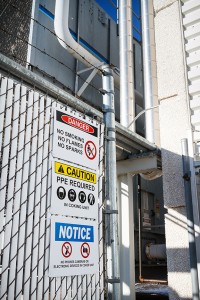
“I saw the sign, and it opened up my eyes…” Ace of base really was on to something with that one hit wonder. Signs are all around us and yet we still miss their messages at times. In the workplace, not being aware of these critical alerts can lead to disastrous situations. While signs outside of work may struggle to stand out amongst the clutter and confusion, a workplace should have streamlined, cohesive approach to how messages are posted, reserving safety signage for the most important safety messages. Here is a rundown of the top 10 most important safety signs every facility should have.
Any time you enter a facility, the first thing you should look for is how to exit that very same facility. In any building that is in compliance with OSHA and NFPA regulations there should be clearly marked exits and unobstructed routes to get to them. You never know when an emergency may occur or just the urge to get out of there!
Everyone has their nosy moments, wanting to see what goes on behind the scenes and out of view; however at times that can go against your best interests when it comes to safety. If there are areas within a facility that should be kept off limits to most, and should only be deemed accessible by people with particular credentials, post authorized personnel only signage at the entry points of those areas and take further steps to secure them from the general public. An area where an authorized personnel sign could be needed could include and HR department where there are private documents or any area where there is lab testing or hazardous chemicals.
When entering into an area of a facility where there are hazards that pose a threat to a workers well being, it is important to alert them to the proper precautions they should take before entering to protect themselves against harm. Areas like this could include a construction site, or a manufacturing floor where there could be flying objects or moving parts.
Anywhere there is a substance that is capable of ignition or causing a fire, there should be a Danger Flammable sign. Often automotive garages that have extra oil and gasoline lying around these signs can be found. In addition, any areas that are used to store chemicals, even cleaning products; should be labeled with this warning as well. Any liquid or gas that is combustible poses a clear and present threat.
The biohazard sign can be found in areas where harmful biological substances are present. Biohazard signs are very common in healthcare settings where bodily fluids are commonly dealt with, that could pass on germs and perhaps disease to others if not properly handled or disposed of.
Electrical safety is an ongoing hot button issue in workplace safety. It holds 3 of the top 10 most cited violations for OSHA, and takes countless lives each year due to improper safety precautions when workers come in contact with it. High voltage signs should be posted anywhere the threat of contact with dangerous electrical current is present. This is a very serious area of concern in all workplaces that it affects, signage is a great first step in getting a workers’ attention and alerting them of an electrical hazard in their area.
A confined space is not intended for continuous occupancy by workers by definition, however at times, it is required for workers to enter confined spaces for maintenance and other tasks. By posting confined space signage at these points of entry, this alerts workers that these areas and the tasks associated with them are only for workers who have been properly trained in working in confined spaces and should only be entered by those who have permits and have gone through the proper alerting processes as it pertains to letting coworkers know of the work they are performing, where, when , and for how long so that they are accompanied by the right personnel for assistance.
When working in the presence of heavy duty machinery it is important to know the functions of each machine to ensure that your workers stay out of harm’s way. A machine that can start up without warming poses a major threat to a worker when it comes to caught-in injuries, lacerations, and amputations. Posting this sign with help to remind an employee about the machine that they are working around however when performing maintenance on a machine the proper lockout tag out procedures should always be followed.
Maintaining a safe flow of traffic around a facility that incorporate forklifts and foot traffic within the same area can come with its own set of difficulties and safety hazards. When operating a forklift around a bustling floor many things can go unheard due to noise or unseen due to blind spots. While the pedestrian should always have the right of way, if a person is unseen and unheard, this is where the danger rises. Posting forklift traffic signs in these areas can help make all workers more aware.
Everyday slips trips and falls are some of the most common and also some of the most costly when it comes to workplace safety injuries. All it takes is an uneven surface, a step down, a box that falls out of place or a chord in a walkway to cause serious injury. If there are known areas within your facility where tripping incidents or near misses consistently occur consider posting a caution sign.
While every workplace safety hazard cannot be solved by safety signage, providing the right alert messaging starts your workplace safety program off on the right foot. When clear, consistent, and cohesive messaging is present, it will provide a strong safety foundation for any workplace to incorporate into their procedures for a sustainable workplace safety strategy.










